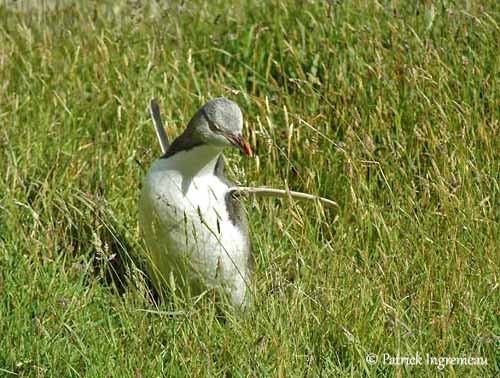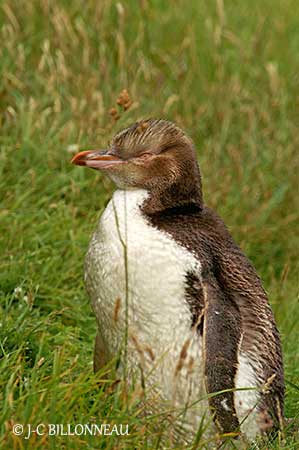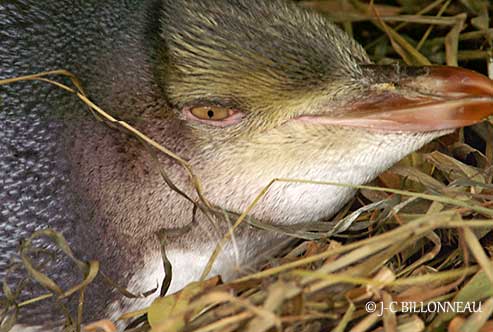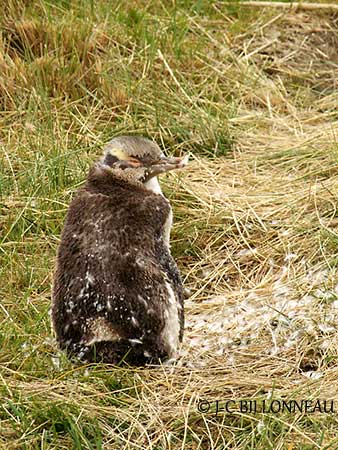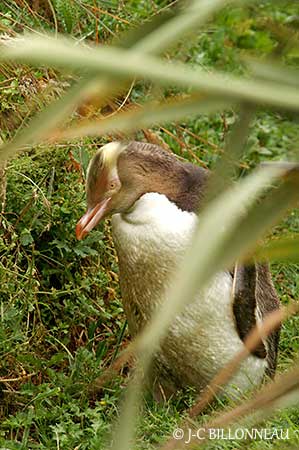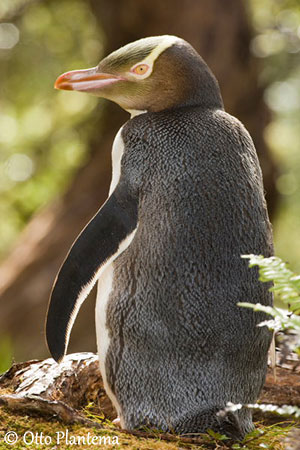
Fr: Manchot antipode
All : Gelbaugenpinguin
Esp: Pingüino Ojigualdo
Ital: Pinguino degli Antipodi
Nd: Geeloogpinguïn
Sd: Gulögd pingvin
Photographers:
Jean-Claude Billonneau
Photographe-témoin de la Beauté du Monde
Patrick Ingremeau
TAMANDUA
Otto Plantema
Trips around the world
Text by Nicole Bouglouan
Sources:
HANDBOOK OF THE BIRDS OF THE WORLD vol 1 by Josep del Hoyo-Andrew Elliot-Jordi Sargatal - Lynx Edicions - ISBN: 8487334105
L’ENCYCLOPEDIE MONDIALE DES OISEAUX - Dr Christopher M. Perrins - BORDAS - ISBN: 2040185607
BirdLife International (BirdLife International)
Animal Diversity Web (University of Michigan Museum of Zoology)
PhotoVolcanica - Photography and Information by Dr Richard Roscoe
PENGUINWORLD (Lloyd Spencer Davis)
Welcome to the Penguin Project
Yellow-eyed Penguin
Megadyptes antipodes
Sphenisciforme Order – Spheniscidae Family
INTRODUCTION:
The Yellow-eyed Penguin is endemic to New Zealand. This species is less social than other penguins and usually nests out of sight of each other. Their breeding cycle is fairly long.
These penguins have suffered huge degradation of their habitat with deforestation of the coastal areas where they nest. In addition, introduced animals affect this species too.
Today, humans are trying to help and protect then by replanting vegetation for nest-sites. But the Yellow-eyed Penguin is currently classified as Endangered.
DESCRIPTION OF THE BIRD:
Biometrics:
Length: 66-76 cm
Weight: 4500-6000 g
The adult has dark slate-grey upperparts and flippers, the latter with white edges.
The underparts are white, with pale pinkish-white flipper’s underside.
The head is paler, mostly yellowish-brown, with yellow band running from the eyes around the hind crown. Forehead and crown are blackish with yellow streaks. Cheeks, ear-coverts and throat are brownish, whereas the chin is pale yellowish. The hind crown and the nape turn blackish while joining the upper back.
The two-tone bill has pale pink lower mandible and red-brown upper mandible and tip. The eyes are pale yellow. Legs and webbed feet are pink with black claws.

RANGE:
The Yellow-eyed Penguin occurs along E and SE coasts of South island in New Zealand. It is also present on Sub-Antarctic Campbell and Auckland Islands, and Foveaux Strait, including Stewart and Codfish Islands. There is a large concentration of this species on Otago Peninsula on New Zealand mainland.
HABITAT:
The Yellow-eyed Penguin lives and breeds in the coastal forests, in densely vegetated areas near the coasts.
This species feeds near the shores, in shallow coastal waters. It is mainly terrestrial and goes to sea only for hunting.
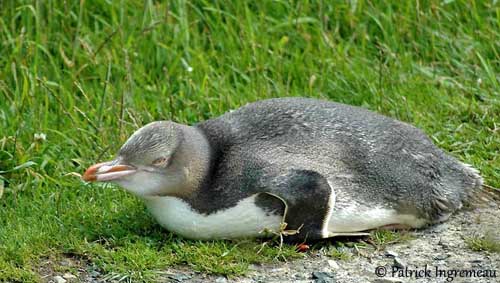
BEHAVIOUR IN THE WILD:
The Yellow-eyed Penguin feeds mainly on fish such as Opalfish, Red and Blue Cod. But it also feeds on cephalopods and crustaceans.
The preys are usually less than 25 cm long, in average between 5 and 17 cm. The diet varies according to the season and the locality.
This penguin takes fish living near the sea-floor of the continental shelf. The foraging dives last 2-4 minutes, at depths of 30-40 metres. But they may be found between 40 and 80 metres, with a maximum of about 150 metres depth. They may dive up to 200 times per day. Their surface speed is around 6km/hour.
The preys are caught by pursuit-diving. The Yellow-eyed Penguin is a solitary hunter and usually forages between 5 and 16 km from the coast.
The Yellow-eyed Penguin tries to avoid contact, but it defends its territory against other penguins. In aggression, the penguin usually leans forwards towards the opponent with hunched shoulders, while making harsh noises. They sometimes charge and peck at a rival, but physical contacts are very rare.
They may adopt an appeasement stance to avoid conflicts.
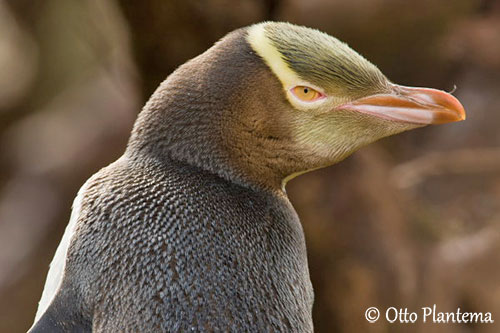
This species has long breeding season. Courtship starts in August and the chicks fledge in March. They do not live in groups and are not colonial. They are monogamous.
The yellow pattern of the head could be indicative of mate quality and used for mate selection.
The nest-site is in dense vegetation in coastal areas, and usually at 100-200 metres from the shore, and between 10 and 30 metres apart. Several nests can be found on steep slopes up to 100 metres above the sea level. But penguins are good climbers. There is high fidelity to the nest-sites.
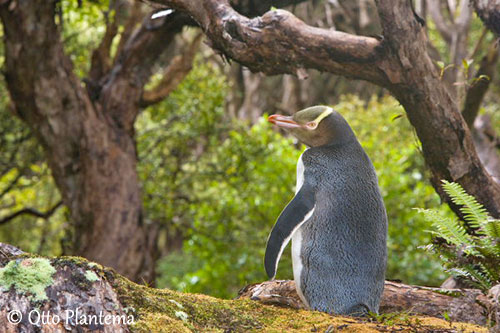
Both mates have long-term pair-bonds. During courtship displays, the birds perform shaking movements, or the head is slightly raised and the flippers are held away from the body. And finally, the most common display performed by numerous penguins, with head pointing skywards with flippers pointing sideways. The mutual preening strengthens the pair-bonds.
The adults go to sea for feeding during a month after the fledging period, and return to land for moulting. During this period, they may lose up to half of their weight. Once the moult is done, they feed again to gain weight before the next breeding season.
The Yellow-eyed Penguin adult is sedentary and remains along the coasts all year round, in the vicinity of the breeding grounds. The juveniles disperse to N, up to 600 km from their nesting areas.
They walk, climb, swim and dive easily and are able to move on land and at sea.
REPRODUCTION OF THIS SPECIES:
The laying occurs in September/October. The Yellow-eyed Penguin nests in densely vegetated areas near the coast. The nest is a shallow bowl lined with dry plant matter and twigs. It is protected from the direct sunlight. It is built in natural hollow, under dense vegetation or between roots.
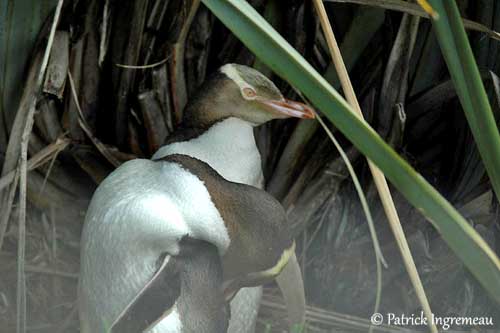
The female lays two eggs over a period of four days. Both parents share the incubation during 39-50 days, with stints of 1-7 days. Parents do not eject any egg, and unlike most other penguin species, they perform “brood maximizing behaviour”. Both egg hatch within 24 hours of each other. The chicks are brooded during the first 25 days, and both parents feed them at nest by regurgitation during 15-25 days. Then, parents go out at sea for foraging.
The young do not form crèches, and fledge in mid-February at 14 weeks old. They moult into adult plumage at one year and the yellow band appears. They are sexually mature at two years old.
